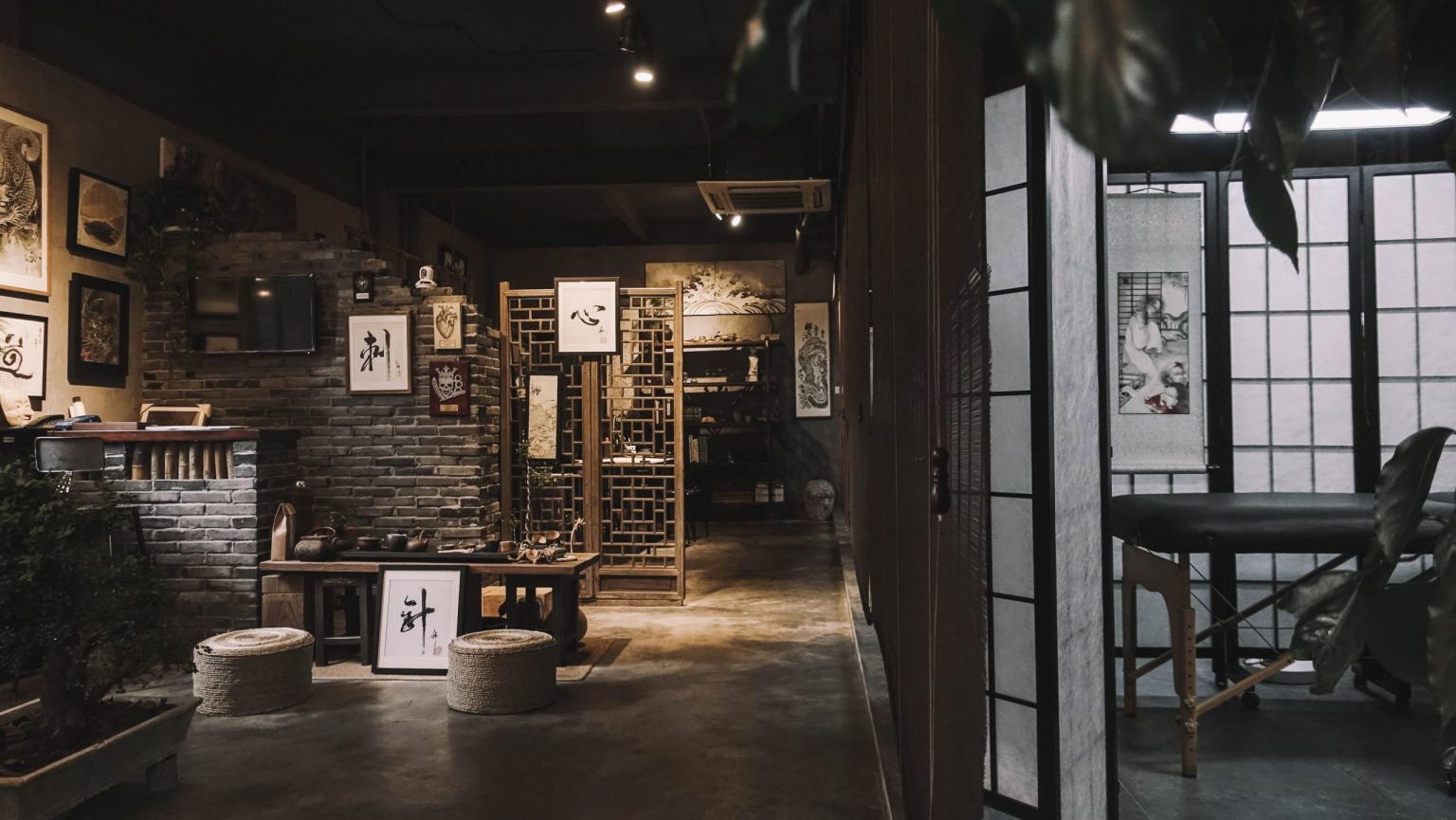This story is presented in partnership with Neocha, a fellow creative publication based in Asia and established in 2006. It explores the Chinese tattoo tradition through the work of tattoo artist Liu Wenlong, which combines both traditional culture and folklore with modern design.
Liu Wenlong is a tattoo artist who splits his time between the cities of Hangzhou (Zhejiang Province) and Hohhot (Inner Mongolia). As one of China’s most famous tattoo artists, he founded Wencui Ciqing Tattoo Studio.
In Liu Wenlong’s name, the Chinese character wen is the first part of the Chinese word for “tattoo,” while the character long means dragon. Over the years, Liu has developed a unique tattooing style that fuses his deep appreciation of traditional Chinese culture with modern tattoo design.
刘文龙是居住在中国呼和浩特和杭州的文身艺术家。作为中国最知名的文身师之一,他也是文粹刺青文身工作室的创始人。“文”是“文身”的“文”,“龙”是“中国龙”的“龙”,带着父母所起之名的刘文龙,热爱中国传统文化,更将自身对中国传统文化的深刻理解注入当代文身中,形成了自己的一套独立系统。

Back in 2005, there were many small tattoo shops in China that specialized in the passing fad of the day: tattooing women’s eyebrows. This fad was a catalyst for Liu’s interest in tattooing, so much so that one day he decided to try out tattooing on himself. He gave himself a simple tattoo and showed it off to one of the local tattoo shop owners. The shop owner was so impressed that he offered Liu an apprenticeship. After a few years, Liu honed his skills and began to focus on traditional Chinese tattoo culture. This marked the beginning of what has now been a ten year creative exploration into the art of tattooing.
2005年的时候,中国街边有很多给人纹纹眉毛之类的小纹绣店。当时的他出于兴趣,想给自己文个身。文完之后,纹绣店老板发现他文的比自己还要好,就接受了刘文龙留在店内工作。而后2007年,他开始做中国传统的文身,并一路摸索前进。于是这一文便是十年。

China’s tattoo tradition is longstanding, with its primary roots in warding off evil spirits and misfortune. For example, when hunters went off into the wild in search of game, certain tattoo images were said to protect them. In other cases, tattoos were symbols used to denote rank or social status within respective Chinese social circles. All throughout Chinese history, tattoos have also been associated with religion, personality cults, and organized crime. But in contemporary China, like elsewhere in the world, tattoos are mostly just about personal self-expression. “People who are into tattoos are those who love themselves, who believe in themselves, and who thirst for freedom. They are fiercely independent and wildly free-spirited. They don’t care what others think. They only answer to themselves,” says Liu of his patrons.
中国文身传统由来已久,最开始的文身主要是为了辟邪。出海打猎都会有特定的图纹以保平安。在文身发展过程中,也有一段时期个人身上所文的图腾是作为社会等级地位的象征,并有带有宗教象征意义,以及严格的等级限制和规范。总而言之,文身这件事不外乎宗教、个人崇拜与符号象征。时至今日,文身更多是一个人的自我表达。“喜欢文身的人,首先是信仰,二是爱’我’,渴望自由。都是特别自由特别独立的一类人,他不会去管别人的看法。他做什么只会问自己。”刘文龙告诉我们,他现在的客户也是这样的人。

The way Liu sees it, “Tattooing isn’t just about turning one’s skin into a canvas, or using a tattoo gun like a paintbrush. There’s much more to it.” Besides a tattoo’s uniqueness and staying power, Liu carefully considers all aspects of the tattoo design. Before he starts sketching a particular tattoo, he needs to know what his customers want to express, their particular skin tone, their muscle form, their attitude, and their outlook. His sketches are followed by scaled mock-ups, color matching, and detailed renderings. This process can take up to a year to complete, and only then does the actual tattooing begin.
在刘文龙看来,文身并非只是“皮肤为画布,文身机作笔”这么简单。文身在一块皮肤上的唯一性和时间上的持续性,让他对每个图形的设计都非常谨慎。在知道客户的想法和信仰之后,他还会细致观察客户的肤色肌肉以及整个人的状态。此后才会作草图,再画与人体等比例的图,最后出一个包括色调搭配等的完整效果图。这一个阶段历时不定,甚至有时候一年也无法完成。


The relationship between Liu’s customers’ muscle forms and his designs is of utmost importance to his creative process. His designs are customized to best suit the shapes and movements of each of his clients’ bodies. In addition to ths, Liu also incorporates Chinese philosophical traditions of the five elements into his tattoo composition. He identifies the three sections of the body as water, land, and air in order to correspond to heaven, earth, and man. “If you look at the composition of my designs on a person’s body, you will notice that the legs and feet typically feature powerful water elements. The mid-sections have a lot of stones or earth elements. The upper body will feature clouds or mist, or things related to the air. ” For Liu, this compositional arrangement gives people power, stability, and strength.
人体肌肉和图形之间的关系也是他设计一个图案极为重要的考量因素。所以,他会设计特殊的线条去配合人体肌肉的运动。除此之外,他还应用到中国的五行理论,将人的身体分为水、陆、空三个部分,以代表天、地、人。“一个人站在那里的时候,脚的位置是下部的中心,所以会用一些比较有力量的水;中间的部分会用一些山石、陆地等,比较上的部分会用一些云雾啊,跟云有关系的东西。”他认为,这样规划的文身在人站起来的时候就有了支撑点了,充满力量。


“The images might seem abstract and fantastical, but its only through this approach that we are able to communicate the full scope and depth of our thoughts.”
Comparing Chinese style to Japanese style tattoos, which also heavily utilize traditional Chinese cultural elements, Liu says, “From design form and visual appeal to significance and meaning, I still prefer the aesthetic of Chinese style tattooing. The Chinese tradition is mostly about powerful, breakthrough imagery that represents meaning and significance through poetic harmony and abstraction. Chinese tattoo artists focus on the storytelling behind the imagery and the hidden gems of inherit meaning. The images might seem abstract and fantastical, but its only through this approach that we are able to communicate the full scope and depth of our thoughts.” Liu plans to continue exhibiting his work at international tattoo conventions with the goal of showcasing the uniqueness and beauty of Chinese tattoo culture to the world.
相较于同样应用了很多中国传统元素的日本文身,在赞赏日本对文化的传承以及文身的细致之余,刘文龙说:“从图案的造型、韵味、意义上来说,我还是比较中意我们中国人的审美。中国文身更多的是突破这个形,要表达的是意义和韵。我们比较注重图案后面的东西。有时候笔没有写实到那个点,但是通过那个点去达意。”他将中国文身带到国外去,也是希望可以让世界知道中国的文身。






















